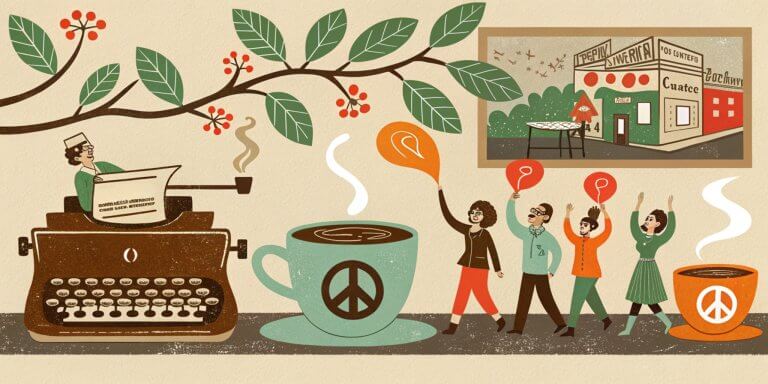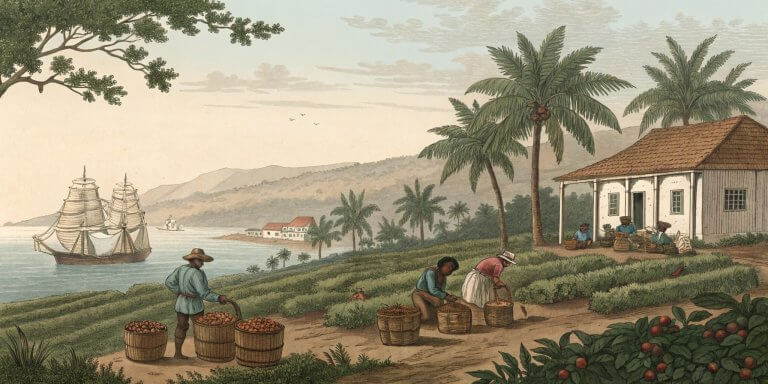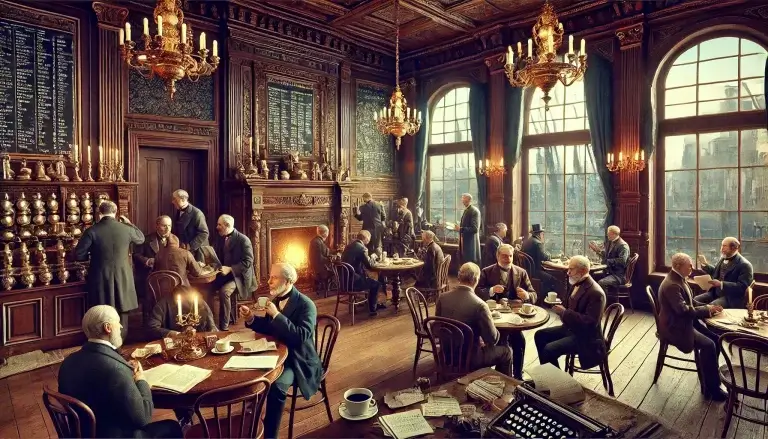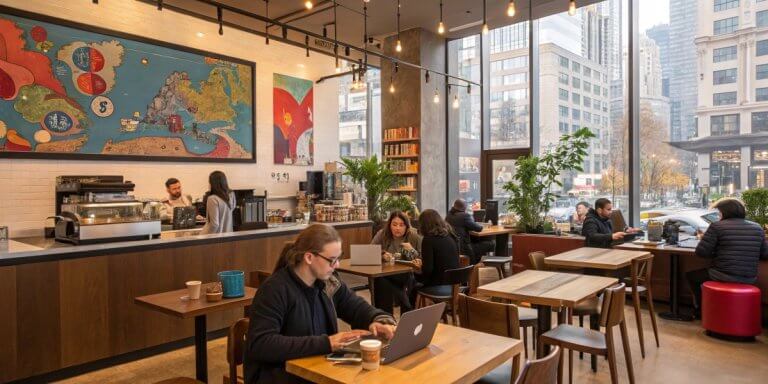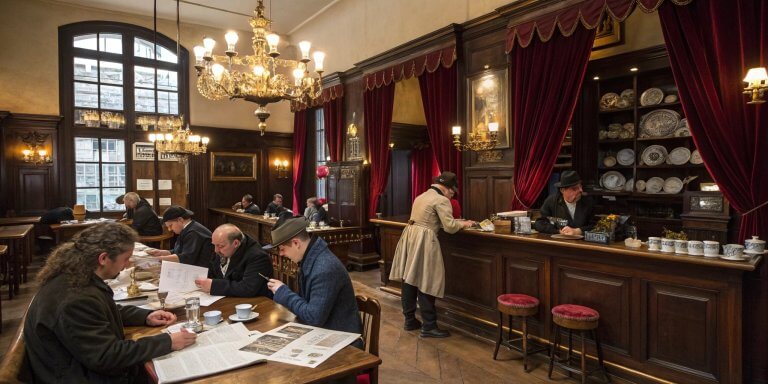
When we think of coffeehouses today, we may picture cozy spaces where people gather for casual conversations or to catch up on work. But centuries ago, coffeehouses were the birthplace of something much more influential: journalism. In the 17th and 18th centuries, these establishments served as bustling centers of information exchange, fostering the development of early news media. From London to Paris, coffeehouses played a pivotal role in shaping public opinion, spreading political news, and laying the foundation for the modern press. Let’s explore how coffeehouses became the cradles of journalism and Journalism’s Roots in Coffee Houses ,their lasting impact on the media we know today.
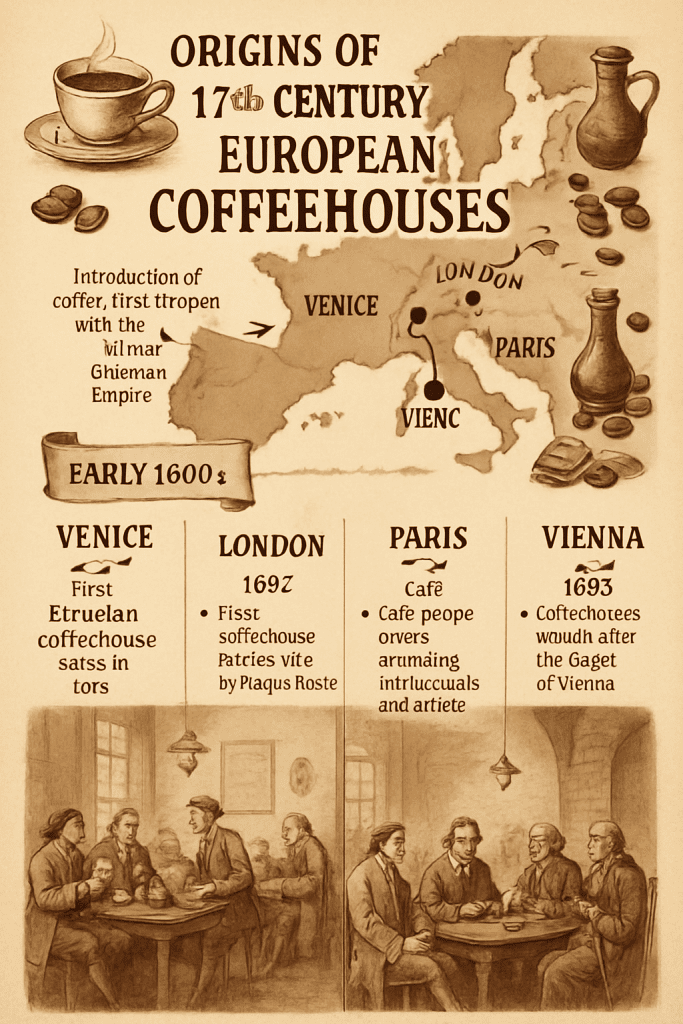
Tracing the first European coffeehouses and their founders
The Emergence of Coffeehouses in Europe
Coffeehouses began in the Ottoman Empire and spread to Europe in the mid-1600s. The first coffeehouse opened in Oxford, England, in 1650, followed by more in London.
These venues quickly became popular among merchants, intellectuals, and scholars. Unlike private clubs or aristocratic salons, coffeehouses were open to anyone who could afford a cup of coffee, making them inclusive spaces where people from all walks of life could gather and engage in discussions, fostering a sense of equality and openness.
The coffeehouse environment was perfect for fostering conversation. Visitors sat at communal tables, exchanging ideas about trade, politics, science, and—importantly—news. This egalitarian setup meant that ideas could spread quickly, and coffeehouses soon became known as places where information flowed freely.
They were often called ‘penny universities’ because, for the price of a cup of coffee, patrons could learn as much from the lively discussions as they might at a formal lecture. These discussions ranged from local gossip to global events, and from scientific discoveries to political upheavals.
Coffeehouses as Information Hubs
Before the development of organized news outlets, coffeehouses served as the primary hubs for news dissemination. These establishments were crucial for staying informed in an era without newspapers or television. People would gather in coffeehouses to hear the latest news, read pamphlets, or listen to political debates. In some coffeehouses, news was read aloud; in others, handwritten bulletins or pamphlets were passed from table to table.
Many of the first newspapers in England were born out of coffeehouse culture. The Spectator, a famous early periodical created by Joseph Addison and Richard Steele, was inspired by the discussions held in London’s coffeehouses.
Addison and Steele used the periodical to address the issues discussed in these social hubs, from politics to society’s moral challenges. Coffeehouses acted as informal newsrooms where editors and writers could gauge public opinion and gather material for their publications.
The Role of Coffeehouses in Political Journalism
During the Restoration period in England (1660-1688), coffeehouses became influential venues for political discourse. The spread of coffeehouses across London made sharing news and opinions about government policies easier, creating a fertile ground for political journalism. Merchants, lawyers, and even ordinary citizens could sit together and openly debate the latest political events.
Not surprisingly, this growing political conversation alarmed the authorities. King Charles II, fearing that coffeehouses were breeding dissent and rebellion, attempted to close them down in 1675. The king declared that coffeehouses were places where “malicious and scandalous reports” were spread, aiming to control the discussions within them. However, public backlash was so intense that the ban was lifted after only 11 days.
This attempt at suppression highlighted how influential coffeehouses had become in shaping public opinion. They were spaces where political news was not just shared but scrutinized, and the discussions in these coffeehouses laid the foundation for political journalism as we know it today, underscoring the significant role they played in influencing public perception.
The Public Sphere and Journalism
Philosopher Jürgen Habermas introduced the concept of the ‘public sphere,’ which refers to a space where citizens come together to discuss and influence societal issues. In the context of coffeehouses, the public sphere was a place where people could discuss politics, economics, and culture, effectively shaping public opinion and making their voices heard by those in power. This concept is crucial to understanding the role of coffeehouses in the democratization of information and the evolution of journalism.

How coffeehouses shaped early public discourse
Coffeehouses were crucial in democratizing information. Before their rise, political conversations were confined mainly to elites. Coffeehouses opened these conversations to a broader public, making them the first actual platforms for open dialogue. This public sphere was essential for the growth of journalism because it created a demand for regular news updates, which led to more formal newspapers and periodicals, empowering the public with access to information.
The International Influence
While London is often seen as the birthplace of coffeehouse journalism, similar developments occurred across Europe. In Paris, cafés like Café de Foy became centers of revolutionary thought during the French Revolution. These cafés were crucial in spreading pamphlets and political news, helping to mobilize the public against the monarchy.
Viennese coffeehouses also played a significant role in the spread of ideas. Writers, poets, and political thinkers gathered in places like Café Central to discuss everything from literature to national politics. These discussions often made their way into newspapers and journals, which were circulated throughout the city.
Coffeehouses across Europe became essential meeting points for journalists and writers, creating an international network for information and opinion sharing.
the Birth of the Modern Newspaper
The structure of early newspapers closely mirrored the lively discussions held in coffeehouses. News was often divided into sections covering politics, trade, and international affairs—just as conversations in coffeehouses usually ranged from local gossip to global events. Publications like the London Gazette and the Daily Courant drew much of their content from the conversations in these bustling hubs.
Lloyd’s Coffee House, in particular, became famous as a gathering place for merchants and ship owners who exchanged maritime news. This coffeehouse eventually evolved into Lloyd’s of London, the world’s leading insurance market and its initial focus on trade and shipping news helped shape early financial journalism.
Decline and Transformation
By the late 18th and early 19th centuries, coffeehouses’ role as centers of journalism began to decline as formal news outlets and printing presses became more widespread. However, their legacy is still felt today. Many of the principles that shaped early journalism—openness, public discourse, and the exchange of ideas—can be traced back to the coffeehouses of Europe. In the 21st century, cafés serve as meeting places for journalists, writers, and intellectuals. With the rise of the internet and digital media, cafés have once again become hubs for exchanging information, particularly for freelance writers and digital journalists, demonstrating the enduring influence of coffeehouse culture on the media landscape.
In the 21st century, cafés serve as meeting places for journalists, writers, and intellectuals. With the rise of the internet and digital media, cafés have once again become hubs for exchanging information, particularly for freelance writers and digital journalists.
Although the public sphere may now be online, the café remains an essential space for discussion and collaboration, carrying forward the tradition that began centuries ago.
Conclusion
The roots of modern journalism can be traced directly to the coffeehouses of 17th and 18th-century Europe. These vibrant spaces fostered discussion encouraged the exchange of news and laid the groundwork for the press as we know it today. Whether in London, Paris, or Vienna, coffeehouses were the cradles of journalism, providing a space for sharing and scrutinizing information. Today, their legacy lives on in the cafés and digital spaces where journalists continue to gather, write, and exchange ideas, ensuring that the tradition of free and open discourse endures.

